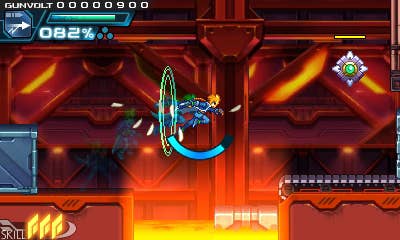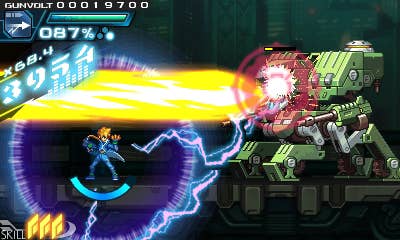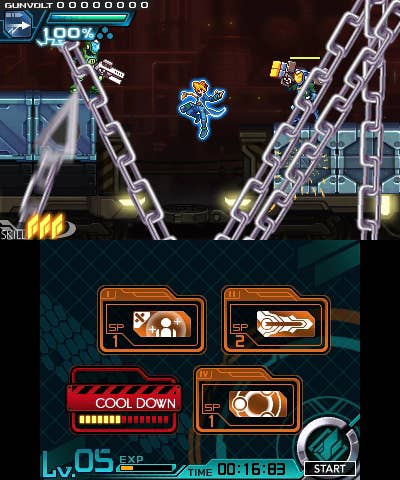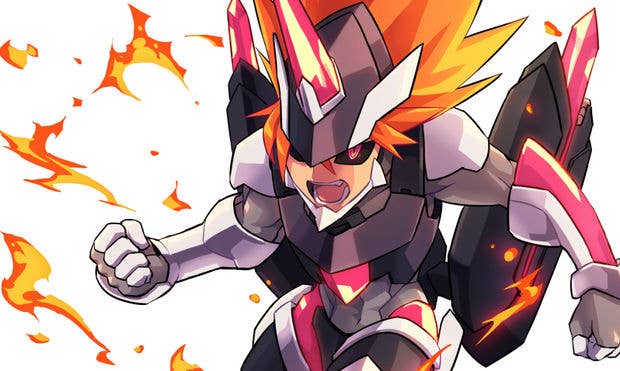Azure Striker Gunvolt 3DS Review: Lightning Returns?
Is this high-voltage platformer the second coming of Mega Man it appears to be?
This article first appeared on USgamer, a partner publication of VG247. Some content, such as this article, has been migrated to VG247 for posterity after USgamer's closure - but it has not been edited or further vetted by the VG247 team.
Le Mega Man es mort; vive le Mega Man. Or at least vive a pretender to the crown, anyway.
Azure Striker Gunvolt is not Mega Man. It certainly does its best to give that impression, but beyond surface appearances the game goes in its own direction. Nevertheless, you can't properly discuss Gunvolt without invoking Mega Man.
This isn't a matter of laziness or lack of creativity; Gunvolt feels in many ways like the Mega Man ZX sequel we never got. Not a true sequel, mind you. The story has no connection to ZX, so the cliffhanger on which Mega Man ZX Advent ended will probably never be resolved. But with Mega Man moribund, the developers behind its most recent entries — IntiCreates, the same studio Comcept has teamed up with to create the even more Mega-Man-like Mighty No. 9 — have moved along to produce a thinly veiled spiritual successor to that work.

Azure Striker Gunvolt follows the adventures of a warrior adept named Gunvolt, who wields electrical energy and battles an army of robot-like bosses. He can tackle their levels in any order, and he can claim their weapons as his own upon defeating them. He wears blue. He can equip numerous power-ups that do things like letting him turn his dash into an air-dash, a double-jump, and so forth. To call it Mega-Man-like seems almost an understatement.
And yet, that connection only holds true on a fairly superficial level. Yeah, the Mega Man spirit is strong with this one... but in practice, Gunvolt plays more like a game by Treasure than anything Capcom ever published, except maybe Viewtiful Joe. This works both to its advantage and its detriment. The action revolves around fairly complex mechanics, with pure shooting taking a back seat to a more obscure and intricate mode of attack. Gunvolt's primary weapon — whether his default pistol or any of the more arcane devices you acquire from defeated bosses — deals tragically little damage to most foes; attempting to win by gunning your enemies down would make for an utterly tedious game experience.
Instead, you mainly use your weapon to tag foes as targets for Gunvolt's secondary attack, an electrical discharge. Holding the right trigger causes bursts of lightning to home in on a tagged enemy, as well as generate an aura that surrounds Gunvolt to damage foes and obliterate many forms of projectiles. The more times you can tag a single foe, the more rapidly you can pour electrical power into it. You can even tag multiple targets to inflict damage on more than one enemy at a time. In fact, several challenges (and even one boss) make this tactic requisite to progression.

This makes for a strange, indirect form of gameplay, which is a big part of why it reminds me of Treasure classics like Gunstar Heroes and Dynamite Headdy. The flow of the action differs from your standard run-and-gun platform shooter, as you spend more time evading enemies and ducking behind cover to destroy them remotely than you do trying to line up your shots. As Mike noted in his preview, the discharge mechanic operates on its own meter, and in order to recharge it and prevent overheating you occasionally need to stop and double-tap down on the D-pad to quickly refill it.
Much of the action strategy inherent in Gunvolt has to do with managing your electrical energy. This holds especially true for boss encounters, where you need to balance the tremendous amount of damage you need to inflict with the need to recharge during the short breaks in their attack patterns. There's another factor to manage as well: By default, Gunvolt comes equipped with an accessory that allows him to automatically dodge any attack provided he's not discharging electricity at the time. Against many of the game's more advanced foes, you're better off playing evasively rather than aggressively, attacking only between their powerful, screen-filling attacks.

(Theoretically, it's possible to remove this accessory and deactivate Gunvolt's auto-dodge skill, but it seems a tall order given how ridiculously over-the-top many boss encounters are. I do look forward to seeing Gunvolt played by the savants on Awesome Games Done Quick, however.)
All of this adds up to a much more sophisticated — which is to say, complicated — platformer. And, much like similarly nuanced action games, such as those by Treasure, the end result proves to be both very cool and terribly uneven.
The inherent issue with such a technical, mechanics-oriented game comes from the question of balance. To put it in Treasure terms again, the designers have to choose whether to go all-in on the mechanics and create a game that demands high-level play from the start, a la Alien Soldier, or to make it more accessible to a general audience but get less mileage out of the elements that make Gunvolt so distinctive to begin with, as with something like Silhouette Mirage.
For the most part, IntiCreates has opted for the latter. And, again, like some Treasure games, the balance never quite feels perfect. Gunvolt's dozen stages tend to feel long and drawn-out. Basic enemies lack variety; you face the same 10 or so bad guys over and over again regardless of the level you're in. The stage mid-bosses are always the same giant bestial mech; the three types of anthropoidal robots you face always use the same predictable attacks. There's never any particular cleverness to the level designs, just the occasional gravitational or mechanical gimmick. The game does a decent job of integrating Gunvolt's electrical attack into the stage elements, usually as a sort of electromagnetic, but none of the levels feel particularly taxing.
On the other hand, the boss encounters take the game from mundane to taxing almost immediately. Several of them, particularly the "surprise" story boss you face a couple of times, turn the learning curve into something more akin to a steep cliff. Each boss has three phases of attack based on their health, and several of them have an irritating habit of unleashing hard-to-dodge instant-kill attacks in their third phases. The bosses demand adept use of Gunvolt's mechanics, but because the rest of the game practically lets you sleepwalk through the action, they feel terribly out of place.



Of course, this is nothing new — all of IntiCreates' Mega Man titles tended to suffer from the same issue. But at least those games tended to demonstrate more creativity in their level designs, not to mention more diversity in the bad guys you faced. Gunvolt has an awful lot of long corridors with a few crates and pits in the way. It feels half-finished in many respects.
And the equipment system deserves mention, too. It reminds me a lot of the lousy Cyber Elf system from the original Mega Man Zero, which offered players tons of interesting gameplay modifiers and then punished them for using those features; here, you have a synthesis system that requires you to collect resources through what amounts to a random lottery at the end of each stage. By the time I reached the end of the game, I'd managed to synthesize a single accessory for Gunvolt, which I didn't even equip. The whole affair seemed completely unnecessary.
In its best moments, Azure Striker Gunvolt creates the sensation of smooth, kinetic action. Dodging nimbly through a tricky sequence feels fantastic, and players who connect with that element of the game will find the motivation to truly master the action and seek the best possible stage rankings. But it's just too uneven to be a masterpiece; skilled players will find themselves bored by the tedious stages between the meaty parts, and casual players will see the bosses as disproportionately difficult to the rest of the game. Gunvolt works as a passable Mega Man substitute, but mostly it just makes me pine for the real thing.
VisualsThe sprites, effects, and character designs look great, but the world design is 16-Bit Platformer 101 stuff.
SoundWith unremarkable music and only a handful of voice clips, Gunvolt's audio seems to be there more as a matter of obligation than due to any real inspiration.
InterfaceBecause Gunvolt looks so much like Mega Man, you'll probably try to play it like Mega Man. This would be a terrible mistake. But it's worth mastering.
Lasting Appealn theory, I can imagine Gunvolt connecting with someone enough that they'd want to max out their rankings and fully master the game. Otherwise, though, it's pretty forgettable.
ConclusionAzure Striker Gunvolt looked like a second coming of Mega Man Zero. It's not, and that's no bad thing; it works on its own terms. However, between a lack of variety and some wild variances in difficulty, you get the impression that IntiCreates needed considerably more time and budget to invest in Gunvolt. It's fun at times, but it never shakes of the sensation of being the first draft of something greater.



